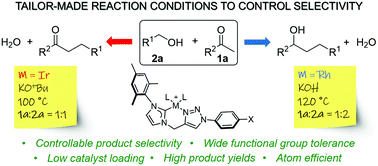Controlling the selectivity and efficiency of the hydrogen borrowing reaction by switching between rhodium and iridium catalysts†
Abstract
The catalytic alkylation of ketones with alcohols via the hydrogen borrowing methodology (HB) has the potential to be a highly efficient approach for forming new carbon–carbon bonds. However, this transformation can result in more than one product being formed. The work reported here utilises bidentate triazole-carbene ligated iridium and rhodium complexes as catalysts for the selective formation of alkylated ketone or alcohol products. Switching from an iridium centre to a rhodium centre in the complex resulted in significant changes in product selectivity. Other factors – base, base loading, solvent and reaction temperature – were also investigated to tune the selectivity further. The optimised conditions were used to demonstrate the scope of the reaction across 17 ketones and 14 alcohols containing a variety of functional groups. A series of mechanistic investigations were performed to probe the reasons behind the product selectivity, including kinetic and deuterium studies.

- This article is part of the themed collection: Breaking bonds over many timescales: in celebration of Robin Perutz’s 70th birthday


 Please wait while we load your content...
Please wait while we load your content...